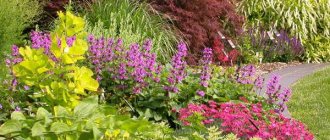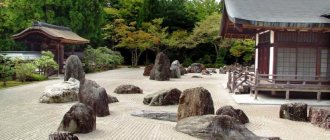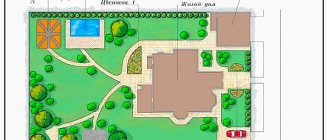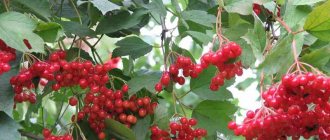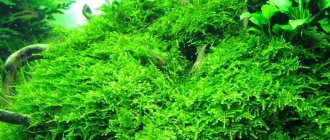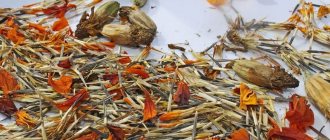In autumn, nature is so picturesque that you can look at the bright red-orange landscapes for days on end. Let's figure out how to create the perfect autumn garden at the dacha.
Landscape designer Vladislav Potapov tells
The poet Alexander Pushkin adored this time of year, when there is no heat, dust and eternally annoying insects - mosquitoes and flies. How to design your garden in a way that will take your breath away?
- You are right: summer has passed, but autumn is no worse. The garden dresses in its brightest colors precisely at this time of year, which is why Alexander Sergeevich loved to walk in the forest during leaf fall, inhaling the subtle smell of mushrooms and the past summer. But Ivan Bunin saw the forest in the form of a painted tower - purple, gold and crimson.
However, you can create a beautiful corner of the forest even on six acres, uniquely transform it, so much so that in the fall it will become even more beautiful and brighter than in the summer. It is necessary to plan and plant decorative varieties of trees, shrubs and flowers to add a catchy palette of warm colors to the cooling nature.
Article on the topic
They are not afraid of moisture. What trees and shrubs are suitable for a wet garden?
Vladislav, is it possible to lay the foundation for the future garden at the end of October?
- Coniferous plants - pines, thujas, spruces, junipers - are replanted before October, so they take root better. But deciduous and herbaceous representatives can be planted until the end of November. Now is the time to plant different varieties of paniculate and tree-like hydrangeas, cinquefoil, lilac, winged euonymus, spirea, colored vesicles with yellow and red foliage, plum-leaved and monopistillate hawthorn, Ginnal maple, decorative forms of rowan, as well as ranetki and ornamental apple trees.
Winged euonymus. Photo: From personal archive/ Vladislav Potapov
The mistake is lack of taste
Is it possible to create only one autumn corner on six acres?
— In a small area it is quite possible to organize several picturesque compositions, the peak of decorativeness of which occurs in the autumn. Just calculate in advance how much space the plants need, whether the site is suitable for the requirements of the crop (location of groundwater, lighting, soil acidity, predecessors, neighbors and other factors).
By the way
Pay attention to plants with a closed root system, sold in pots. They are conveniently planted from late April to November.
Vladislav, what rake do gardeners most often step on when creating an autumn composition?
— Usually they are overloaded with color accents; representatives with red, orange and bright pink foliage are planted almost in a row. One can understand the desire of the owner of the site to create a collection of ornamental plants: it is simply impossible to take your eyes off the beautiful forms. But in the end it just turns out to be tasteless, which makes your eyes tired. The same mistake is made in the interior by pasting wallpaper in bright colors on the wall, which quickly tires the eyes and makes it unbearable to look at.
I advise you to stick to the chosen style, catch a special mood, find a special highlight when creating a garden. The autumn palette should consist of three, maximum four bright accents. Moreover, each accent plant should be separated from the other by different evergreens (mountain pine, common, medium or Cossack juniper, western thuja, dwarf forms of fir) and deciduous plants with yellow foliage (linden, bladderwort, lilac, some types of spirea, mock orange).
One rule remains: in the summer, 1-2 accents are enough for a small garden, to which in the fall are added 2-3 more plants with bright autumn colors. Use your imagination and be creative in the design of your site.

Composition of coniferous shrubs and barberry Thunberg Atropurpurea. Photo: From personal archive/ Vladislav Potapov
Fruit and berry garden on 4-6 acres of land
How to plant a garden on 4 or 6 acres of land Having become the owner of a small plot of land, each of us strives to get the maximum benefit from a minimum of acres. Of course, I want to plant a garden and grow fresh vegetables and enjoy beautiful flowers. What can be planted on 4-6 acres of land? Where to begin? The proposed agricultural technology for growing a garden includes:
Soil composition and its fertility. Groundwater height. Soil composition, soil acidity. What can be planted, and most importantly how much. Gardeners' mistakes. Scheme for laying out a garden on 6 acres. Video of planting a garden on 4-6 acres.
Assess the suitability of your site for growing the desired crops.
Pay attention to the topography, because smoother surfaces are suitable for planting a garden, but planting a garden is also possible on slopes. On very steep slopes you cannot do without terraces. You should know that on the southern and southwestern slopes the soil warms up better, but its moisture supply is worse. The northern and eastern slopes are rich in snow in winter, but trees can be damaged by cold winds. In spring there is more moisture on them, but the earth takes a long time to warm up. In the lowest places, a flowering garden may suffer from frost.
Soil composition and fertility.
Sandy and clay soils will take a lot of time, effort and money to increase their fertility and improve their structure. It is necessary to apply manure, humus, peat and sow sederats (cereals, white mustard, phacelia, etc.)
Height of groundwater.
For apple and peach trees, pears, cherries and apricots, the maximum proximity to groundwater is 2 meters. For plums and cherries - 1.5 m and for shrubs 1 m. If these requirements are not met, your fruit trees will begin to dry out from the top and bend prematurely.
Soil composition soil acidity
Soil acidity is of no small importance for any plant.
You can determine it yourself with simple tests or send it to an agrochemical laboratory (if you wish). Even after examining the weeds on the site, you can roughly tell what kind of soil you have. Too much horsetail and sedge grasses grow in acidic, waterlogged soil. This means that the area will have to be limed and drained. And this is not the only drawback; usually on such soils, under the arable layer, gley horizons lie too close (pressed gray clay, very hard, when you dig, crumbles like crushed stone) in which the root system dies.
Nettles and nettles like alkaline soil, but you are unlikely to get rich harvests from it - you need to add peat and pine needles (they also acidify well). But if your plot is covered with a continuous carpet of wheatgrass, I don’t even know what to say... should you be happy that the soil is close to neutral or grieve over the incredible indestructibility of this weed and its other delights. After all, where wheatgrass grows, the wireworm always lives, its roots are its home and food supply. You will have to deal with two misfortunes at once.
What can be planted, and most importantly how much.
It is better to plant varieties zoned for your region. I understand that I want to grow something delicious, but I myself am guilty of this. But often our desires are completely at odds with reality, and it is very disappointing to lose expensive seedlings in the first winter. Sometimes mistakes when planting a garden are discovered too late, so it is better to avoid them at the planning stage.
Let's start with the fact that, according to the law, large trees can only be planted at a distance of 3 meters from the boundaries of the neighboring plot, and shrubs at least 1 meter. A plot of 4-6 acres can accommodate 9-12 vigorous pear and apple trees, no more than 10 stone fruit trees, 15-20 different shrubs (gooseberries, currants, etc.) and 20-25 raspberry bushes.
Trees are planted in rows with normal topography from north to south or across slopes. The optimal distance between rows and seedlings of apple trees is 6x4m, pears are 6x3m, cherries are 6x3m, plums and cherries are 4x3m, peaches are 3x2m - we are talking about tall varieties. The best compactors (so that the space is not empty before full fruiting begins) among tall trees can be columnar fruit varieties that begin to bear fruit early and take up very little space.
Gardener mistakes
The mistake is made by gardeners who do not take into account the habit of mature trees (the temptation is great, because the seedling is so small) and the fact that between their crowns there must be a clean corridor at least 2 m wide. so after ten years they get an impenetrable woven jungle from the branches of the crowns. Agree, cutting them off later is like sawing a piece of yourself. It’s a pity, but processing is becoming increasingly difficult and you have to either sit without crops (scab, fruit rot and other joys), or chop them to the quick.
You should not plant fruit trees and shrubs along the perimeter of the site - this complicates pesticide treatments due to different periods of flowering and fruiting. For example, you need to spray an apple tree, and next to it there are ripening currants or raspberries. The tallest plants are planted on the north side, and shrubs and berry gardens are planted to the south, so that the “high-altitude plants” do not block the sun for smaller plants.
There cannot be any templates when laying out a garden, but by following the basic rules that I have listed, you will avoid many problems that will then have to be solved too radically. Carefully study what varieties you can plant on your site and write down their names and characteristics. From my own experience, I know how your eyes widen when faced with the abundance of seedlings on offer, everything gets confused in your head, and that’s what sellers need. They will describe the variety to you in such a way that it seems like you didn’t want it, but you’ll take it.
Only they are unlikely to tell you the shortcomings that this or that variety has.
For example, a seedling may be resistant to major diseases (this, of course, will be advertised from the heart), but it is very frost-resistant (they will remain silent) and the tree will freeze in our 20-degree frost. Look for the varieties that you need and do not give in to persuasion to replace them with others. I also want to remind you that it is better to buy seedlings in nurseries, and not at spontaneous sales. Ask for certificates of conformity of the variety, documents confirming that the nursery does not have quarantine diseases and pests, and its activities in the given territory are permitted by Agricultural Supervision.
Garden layout diagram.

Video of planting a garden on 4-6 acres.
Blooming garland
The classics of the genre stipulate that the composition consists of 3 tiers. Which representatives are best for the bottom one?
— The cinquefoil shrub looks amazing in it. These perennial shrubs reach a height of 30–90 cm, depending on the variety. Their most amazing quality is continuous flowering for 3–4 months (in warm spring, they begin to open their first buds already in the third decade of May). And this process ends in late autumn, when the snow covers the plant from frost. Another unusual property is that the branches are decorated not with single ones, but with lush garlands of yellow, pink and red flowers. For example, in the Manchu variety they are whitish with a soft creamy tint, in Pink Queen and Princesses they are pink, Floppy Disc are pink-red, Red Robin are red, Hoplace Orange are orange.
Also suitable for the lower tier are dwarf and creeping forms of conifers, for example, spruce Nidiformis, common juniper Repanda, mountain pine Hampi, horizontal juniper Lime Glow (yellowish-light green), Blue Chip (bluish-gray) and many others. I note that in the fall the needles of the horizontal juniper Andorra Compact acquire a bronze-brown color.

Cinquefoil bush. Photo: From personal archive/ Vladislav Potapov
Blooms before winter
What flowers are best to choose for the lower tier so that they please the eye both in the rain and in the snow?
— Perennials, such as bush aster, look most impressive. Even frosts are not a problem for her; she continues to bloom as if nothing had happened. It reaches a height of no more than half a meter. Asters go well with sedum, a succulent from the Crassulaceae family. One of its forms is especially interesting - Matrona. This bush is low, up to 60 cm tall, its inflorescences are collected in corymbs with a diameter of 10 to 20 cm. Flowering begins in July and ends during sub-zero temperatures. The leaves are also unusual, colored purple. The bush has a dense crown and does not fall apart.

The sedum is prominent. Photo: From personal archive/ Vladislav Potapov
There is another stately flower from the genus of perennial herbaceous plants - Carmichel's aconite. It continues to bloom with purple flowers when the garden has already lost its leaves and is empty.

Carmichel's aconite. Photo: From personal archive/ Vladislav Potapov
We divide the area into zones
Taking into account the initial plan that was created on paper, it is necessary to plan functional areas in the garden area.
When planning to place a car parking space on 6 acres, you should not place it in the depths of the site. Because this way you will steal the precious meters that will be required for transport to travel to the parking spot. Therefore, it is better to place the parking lot closer to the entrance, on the edge of the site.
Are you planning to plant vegetables in your garden? Then you should not plant a garden in its shady, southern part. The best option for placement in a shaded area would be to create a recreation area, as shown in the photo.
When placing a barbecue, consider which direction the wind most often blows in the area. This factor is important to consider so that when cooking over a fire, you do not have to breathe smoke in your area.
If there is a slope, remember that water will inevitably accumulate at the lowest point. This means that you should not create vegetable beds in this garden area, but rather build a natural, albeit small, pond here. We see an example of a design with a pond in the photo.
Hortense - pompous beauty
In the middle tier, hydrangea looks advantageous. Its species are represented by trees, shrubs and vines. One of them - paniculata hydrangea - just like the cinquefoil, goes under the snow blooming, as if challenging nature. Which variety is best to plant in the middle zone and what does it combine with?
— Of course, the two most advantageous types of hydrangeas for landscape design are paniculate and tree-like. They are beyond competition. For example, the Vanilla Fraze variety, which blooms with huge pink and white heads, is especially popular in the middle zone. The plant reaches a height of 1–2 m. The peculiarity of hydrangea lies in the ability to form not only a bush, but also the size of the inflorescences. When pruning, some gardeners leave only a couple of buds on the shoot, and the flower heads reach enormous sizes - up to 50 cm in length. However, sometimes under the weight of heavy rainfall they can break off - keep this important point in mind, you will have to put up supports. The peak of flowering occurs in October, and the variety gains flowering power by the 3rd–4th year of life.
It is best to combine hydrangea with cereals, Japanese spirea, junipers, mountain pines and cinquefoils. It will not be too catchy, but quite a trendy composition for 2 seasons - summer and autumn. For the same purposes, you can use the expressive gray spirea Grefsheim. This hybrid can reach 2 m in height. Snow-white inflorescences adorn the plant from May to June; they resemble spirals in shape. When you look at them, it seems as if a foam party has begun in the garden and cannot end. She presents another pleasant surprise in the fall, completely changing her appearance, turning her grayish-green leaves into bright yellow.

Autumn colchicum. Photo: From personal archive/ Vladislav Potapov
Barberry - a playful tapeworm
What else will look spectacular on this tier?
— Some varieties of mock orange (Belle Etoile, Dame Blanche, Manteau d'Hermine), as well as purple willow Nana, bladderworts, mountain pine (forms Gnome, Pug, Ophir, Winter Gold), some forms of thuja, and winged euonymus are incomparable in the middle tier. The mountain pines Ophir and Winter Gold are notable for the fact that their needles change color from green in the summer to yellow-golden in the autumn-winter period.
Separately, I would like to talk about one of the most expressive accents, about Thunberg’s barberry. Breeders have developed many varieties, hybrids and forms of this plant. For example, the variety of Polish selection Natasha has pink, green and white foliage. The Pink Queen variety has leaves that correspond to the name, but they have delicate white streaks. The bicolor Golden Ring variety has purple-red leaves with a yellow border. Moreover, this bright and expressive shrub is suitable for both the lowest and middle tier, depending on the height of the plant. The peculiarity of barberry is its extreme unpretentiousness. Watering is only required for seedlings, and it prefers slightly acidic soil. The plant fully realizes its genetic potential in a place rich in sunlight, but in the shade, yellow, pink and purple leaves become the most common - green.

In the foreground are barberries, in the distance is (red) European euonymus. Photo: From personal archive/ Vladislav Potapov
Our giants
Which representatives in the composition will be the tallest?
— Classic lilac with double inflorescences, hawthorns, European euonymus, Ginnala maple and Norway maple, decorative forms of mountain ash, linden and oak. The Freeman maple looks shocking, its foliage is painted in a yellow, red and orange palette. By the way, it is good not only in the “extras”; due to the beautiful conical shape of the crown and impeccable self-sufficiency, it is also quite suitable for the role of a tapeworm.

Hawthorn plumfolia Splendens. Photo: From personal archive/ Vladislav Potapov
Surely at least one practical gardener will think that, of course, ornamental varieties and hybrids are good for beauty, but are there plants with double benefits: both spectacular and edible?
— Decorative apple trees have come into fashion. The Rudolph variety apple tree is interesting; it decorates itself with bright pink flowers. Its foliage is green in summer and bright red in autumn, the same as its fruits.
Some varieties of decorative ranetki bloom with white, light pink and even purple flowers. The fruits are also different, they are yellow, purple and dark red. In some varieties of decorative ranetki, the foliage turns yellow by autumn, and small fruits remain on the branches until the New Year, if birds do not have time to peck them. There is a form of the Golden Cherry apple tree, in which the fruits are yellow and the barrel is pink. In autumn, the foliage of the variety turns yellow, which is good to take into account when composing the composition.

Decorative apple tree under the snow. Photo: From personal archive/ Vladislav Potapov
What to plant on 6 acres: trees, plants, shrubs and flowers
“The best set of trees, shrubs and flowers for planting in the country” - is such a guide possible? Of course, but each climate zone has its own additions and exceptions. We will give you universal recommendations
In the Leningrad region and Moscow region, there are practically no climatic differences, but in the Kuban and Crimea the set of plants for the garden will be significantly different.
Hence the objective difficulty of issuing general recommendations, but many species are “generalists” and are able to grow both in the north of the temperate zone and in its south. That is, it will be useful to almost everyone.
By the way, for annual flowers there are practically no features of latitudinal distribution.
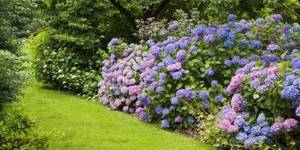
Our opinion:
— Depending on what type of landscape garden you are trying to organize, you will have to choose certain plants for planting. The main thing is the beauty and intuitive matching of the components. This approach is quite justified for a small plot of 6 acres.
Group of decorative deciduous trees
Fans of the so-called landscape style prefer to use exclusively local species for landscaping. For a small area, planting ordinary trees is not applicable due to their large size and extensive crown, which will shade most of your or your neighbor’s territory.
Among decorative deciduous trees, downy and silver birch, including its compact forms, are quite frost-resistant. Rowan - ordinary, intermediate, mealy, American. Maples - Manchurian, silver, Ginela.
In spacious areas you can plant red oak, horse chestnut, Norway maple, small-leaved and large-leaved linden, as well as decorative types of bird cherry (Maaka, virginiana), Lamarck serviceberry, Japanese crimson, and caragana.
Fruit and ornamental trees
Among fruit trees for the garden today, they try to choose low-growing varieties of dwarf and semi-dwarf species. They take up very little space, bloom decoratively, and picking fruits is easy; They are suitable for a small garden or a fruit corner in an ornamental garden. Interesting are the columnar varieties of apple trees, which practically do not produce lateral skeletal branches, while maintaining high fruiting (varieties “President”, “Valyuta”, “Iksha”, “Malyukha”).
Very fashionable multi-varietal seedlings, consisting of several varieties of apple or pear trees on one trunk. When trees grow from such seedlings, it will be possible to collect various types of fruits from them. We offer a list of the best varieties of main fruit crops, zoned for the Moscow region (Moscow region):
- summer varieties of apple trees: Melba, Breading, Mantet, Ottawa-272;
- autumn varieties of apple trees: Streifling, Bessemyanka Michurinskaya, Cinnamon Striped, Dessert Petrova; Melba red; Autumn Joy, Streifling Red;
- winter varieties of apple trees: Antonovka ordinary, Cinnamon novoe, Wellsie, Pepin saffron, Slava Michurinska, Vityaz;
- late winter varieties of apple trees: Mayak, Lobo, Zvezdochka, Voskhod, Northern Sinap, Shafrannoye;
- cherry varieties: early - Bagryannaya, middle - Griot Moskovsky, Vladimirskaya, Smena, Polevka, Black consumer goods, late - Lyubskaya, Shubinka;
- pear varieties: early - Tonkovetka, medium - Bessemyanka, Lyubimitsa Yakovleva, Naryadnaya Efimova, Autumn Bergamot, Venus, Severyanka;
- plum varieties: medium - Hungarian Moscow, Tula black, Pamyat Timiryazev, Skorospelka red, Skoroplodnaya, early late - Iskra, late - Record.
A group of decorative conifers. Trees
Conifers are good for many reasons, and the main one is evergreen. In winter and summer - one color, but not only green. Various species of conifers, especially those that have undergone selection work, can delight in a wide range, from silver-ash to yellow and dark green.
The texture of needles and twigs adds decorativeness; the variety here is also very great. Below is a far from complete list of the most popular types, which are very cute and some are quite compact:
- weeping weymouth pine;
- Korean fir;
- bristlecone pine;
- Weymouth pine with twisted needles;
- Japanese umbrella pine;
- golden Korean spruce;
- Japanese white pine;
- eastern white pine;
- Canadian hemlock;
- blue spruce.
A group of decorative conifers. Bush forms and mini forms
Bush forms of conifers are the most decorative in landscape design because they can be seen at one glance. Compactness and beauty are the main advantages. There are also simply low trees that are not classified as bushes, but we will include them in the list based on size.
Mini-forms of conifers include plants that can and should be used in alpine hills and on rocky slopes, in rockeries. Some of them are creeping forms that form a coniferous carpet. Together with bush plants, they may well be present independently in a thematic landscape garden. It is impossible to list all varieties and types, here are some of them:
- dwarf Albert spruce;
- mountain pine;
- prickly spruce;
- junipers (Blue Star, scaly Blue Carpet, Coastal and others);
- Thuja occidentalis Globoza;
- microbiota is cross-paired;
- Thuja occidentalis Rheingold;
- yew berry.

Ornamental shrubs
Ornamental (ornamental flowering) shrubs can easily decorate the garden on their own - this is what happens in small areas. Shrubs can be from the first tier, not high from the ground, but they can also look like multi-stemmed small trees.
The decorative value of shrubs is almost always underestimated; all attention and love goes to flowers. Flowering and simply beautiful shrubs for spring, summer, autumn and for the whole season - in our short list:
- forsythia;
- spirea;
- triloba almond (often mistakenly called sakura);
- garden lilac;
- mock orange (garden jasmine, but not jasmine);
- kerria japonica;
- camellia;
- hydrangea;
- rhododendron;
- azalea.
Fruit and ornamental shrubs
There are fewer fruit and ornamental shrubs than ornamental ones. Almost all of them are prickly, with rare exceptions, and therefore are used with triple benefit: they are beautiful, function as the most reliable barrier and supply the owners with berries. Here is a list of medicinal-decorative-barrier representatives of this group:
- rosehip, wild rose. The wrinkled rose hip, or rugosa rose (R. rugosa), has the sweetest fruits compared to other rose hips;
- barberry;
- garden teren;
- hawthorn;
- early fruit varieties of currants: Pamyat Michurin, Golubka, Chernaya Lisavenko, Vystavochnaya, Naryadnaya, Altai dessert, Early sweet (white); medium: Leah fertile, Stakhanovka Altai, Bradthorpe, Dutch red, Chulkovskaya (red) and late variety Pobeda;
- fruit varieties of gooseberries: early - Moscow red, Pink; middle ones - Russian, Smena, Kolkhozny, Krasnaya Zarya; late - Finik, Lada, Finnish I;
- medium raspberry fruit varieties: Novost, Kuzmina, Newburg, Kaliningradskaya, Kostinbrodskaya; mid-late variety Ottawa and late variety Latham;
- not a shrub, but we present early fruit varieties of strawberries: Krasavitsa Zagorya, Vnuchka, Early Maheraukha, Zarya, Leningradskaya early; medium: Festival, Komsomolskaya Pravda, Ideas, Purple, Redcoat; later: Talisman, Zenga.
Decorative deciduous annuals and perennials
Decorative foliage plants have brightly and contrastingly colored foliage, rivaling the beauty of flowers.
Some species combine the beauty of both leaves and flowers, increasing interest in them among amateurs and professionals. The most popular decorative plants (by foliage) are on our list:
- coleus;
- begonias;
- hosts;
- caladium;
- ryegrass
Roses
There are a great many varieties and types of roses. With their help, you can create a magnificent rose garden or create accents by placing roses in groups in the garden or in any flower bed.
Here are the most recommended varieties for landscaping/decorating the area, grouped into groups according to appearance, origin and functional purpose and suitable for our conditions:
- park roses for the Moscow region: White rose (rose hips) and its varieties, cinnamon rose, gray or red-leaved rose, wrinkled rose, or rugosa, and its varieties and hybrids: Golden Wings, Pink Grootendorst, Agnes, Moe Hammerberg, Queen of the North, Hansa ;
- hybrid tea roses: Ave Maria, Alexander, Baron Edmond de Rothschild, Berolina, Blush, Harry Wheatcroft, Gloria Day, Dame de Ker, Dolce Vita, Evening Star, Karina, Clementina, Chrysler Imperial, Mercedes, Pascali, Raphael, Rose Gozhar , Rother Stern, Satan, Super Star, Tatyana, Tiffeny, Morning of Moscow, White Christmas, His Majesty, Electron;
- roses of the floribunda group: Red Gold, Lipli Marlene, Frisia, Circus, Manu Meillan, Diadem, Bluewunder, Galaxy, Carte Blanche;
- roses of the grandiflora group: Queen Elizabeth, Komsomolsky Ogonyok, Leo;
- group of miniature roses: Baby Masquerade, Gnome, Debut, Hummingbird, Coraline, Maidy, Magic Carrusellin, Pixie, Pompom, Rosemary, Rosliny, Chipper, Eleanor;
- climbing roses. Ramblers: Dorothy Perkins, Excelsa, Bobby James, Paul Noel. The bulk of modern climbing roses with large flowers belong to the Clymer group: Pink Claude, Rosanna, Elf. There are several old varieties of climbing roses that combine both large flowers and a flexible bush. These include: Newdown, Constance Spry, Zephyrin.
Annual flowers
There are annual flowers for garden decoration... it’s not very clear which number to pronounce. There will probably be a hundred of the most common species. And if you count exotic flowers, of which more and more appear every year, then the count will go to a couple of hundred.
Naturally, exotic plants grow beautifully in tropical conditions, but with proper care they can be used in the summer as a decoration for a site here in the middle zone.
Perennial flowers in the garden
Perennial flowers, or perennials, are ornamental plants that retain their picturesque properties for more than two years. These flowers are ideal for the garden. They do not require annual transplantation or any special care. Once planted, you can enjoy their beautiful color for the next few years. When planting perennial flowers, very careful consideration is required in terms of planting location and type.
Unlike annuals, this group settles in earnest and for a long time. Of course, even small trees and bushes, not to mention perennial flowers, can be replanted from place to place.

Perennial vines
Perennial vines are great for vertical gardening. Their use in a small area compensates for the small size of the free space - the vine is launched onto the facade, providing it with a strong and reliable foundation for many years.
Directly on the site, vines are good as a hedge along any type of fence, in pergolas and on gazebos, to completely camouflage outbuildings. Types recommended for use:
- wild grapes;
- fruit grapes;
- actinidia;
- Honeysuckle-Honeysuckle;
- clematis;
- ivy;
- wisteria (only for the south or winter garden);
- kampsis.
Annual vines
Annual vines are very diverse, it is worth mentioning at least passionflower (alas, not for our conditions, only in the room/greenhouse), morning glory, ornamental beans, and there are also many dozens of other species. Along with the great differences in the appearance of these vines, there are also common features, for example, almost all have long stems from which there are no lateral branches, greenery and flowers of a very attractive appearance.
Annual species serve as an excellent decoration for balconies, terraces, fences and the summer cottage itself. Climbing annuals should be planted where the soil is frequently turned over. It should be a sunny place; vines need light for good development.
The species diversity of vines allows you to create various combinations. But you have to replant annuals every year and at the same time make sure that the seeds they scatter do not germinate in inappropriate places, because vines can easily crowd out other flowers from the flowerbed. Recommended types for use:
- morning glory;
- sweet pea;
- decorative beans;
- hybrid nasturtium;
- echinocystis;
- climbing kobeya;
- Thunbergia winged.
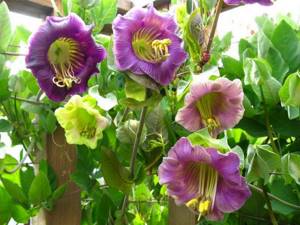
Ampelous
Annual hanging or cascading flowers can be placed in the garden on gazebos, in high lawns, directly on the house, and so on. Their lashes, hanging freely down, are beautiful in themselves, and in case of abundant flowering, they are simply irresistible. Naturally, these plants delight us only during the season; they do not know how to winter outside.
- petunia: Million Bells Cherry, Nerra Cotta, Parple Vane, Marco Polo;
- ampelous fuchsia. All varieties grow in partial shade, the Aloha variety is not afraid of the sun;
- diascia;
- Snapdragon;
- the snapdragon, a relative of the snapdragon;
- verbena: Temari, Tapien;
- ampelous decorative foliage crops: immortelle, plectranthus, tradescantia, chlorophytum.
Ferns
All ferns, without exception, are decorative. Their beauty is very unusual, archaic and advantageous in almost any garden - if they are positioned correctly. In addition to the well-known and familiar bracken:
- azolla - a tiny fern that floats on the surface of the water and forms a dense carpet;
- ostrich;
- sensitive onokleya;
- chistoous (osmunda);
- salvinia is another type of floating fern;
- bracken
Dwarf/compact trees
The popularity of naturally small trees and selectively bred dwarf/compact forms is extremely high and is exploding in the domestic market. There are many reasons for this - high decorative value, the ability to plant several plants at once in a tiny area.
In addition, it is easy to buy an almost mature plant. There are coniferous, deciduous ornamental and ornamental fruit species on sale.
Plants for alpine hills, rockeries
For alpine hills or rockeries, plants that can tolerate dry conditions are suitable. Therefore, in decorating these elements of landscape design, mostly species that came into culture from mountainous regions are used.
In addition, any succulent forms, including cacti and euphorbia, can serve as decoration for the slides (at least from spring to autumn). They must be evacuated to heated premises for the winter.
For a large alpine hill you definitely need conifers and low-growing deciduous shrubs. The classic basis is ground cover (“carpet plants” are low-growing, creeping, rapidly growing) perennials; they form a cover, look beautiful between stones and are picturesque from early spring to late autumn. A list of the main plants that seem to be created for an alpine hill:
- dwarf spruce;
- compact and creeping junipers;
- thujas of bushy and columnar-pyramidal forms of small height;
- small cypress trees;
- cotoneaster horizontal;
- Iberis;
- dryad;
- short-stemmed carnation;
- rock alyssum;
- young;
- saxifrage;
- group of early flowering plants: snowdrops, scillas, chionodoxes; late tulip, Pushkinia, poultry; autumn crocuses and colchicums. Primroses, coltsfoot, low forms of heathers, Irish moss (bryozoan, sagina).
bed
The decorativeness of a vegetable bed - if properly organized - is not much inferior to decorative leafy plantings. The so-called French (elevated, warm) vegetable garden is gaining decent popularity today. But even without it, you can always arrange a traditional garden bed of several square meters somewhere in the back.
Here's what you can plant and get a guaranteed harvest without much hassle: lettuces (all varieties and types), radishes and radishes, cilantro, parsley, dill, regan and other green crops that are compact in adult form; bell pepper (mini-form), bitter pepper (“spark”); dwarf forms of tomatoes and other mini-vegetables, still rare in our area; collard greens, carrots and different types of onions, garlic, herbs.
Our opinion:
— This material in no way purports to serve as instructions for selecting plants for your landscape garden when landscaping. This is just an introductory note to get newbies up to speed. There are too many variables in each case, one of the main ones is the climate zone and the weather and temperature background in a particular area.
Source

